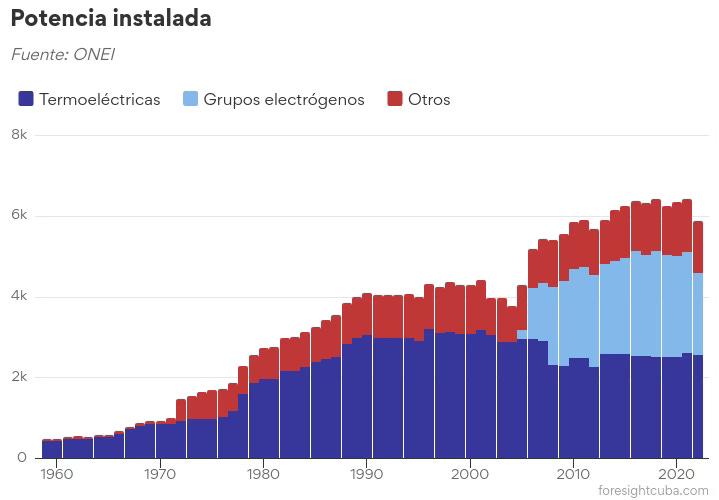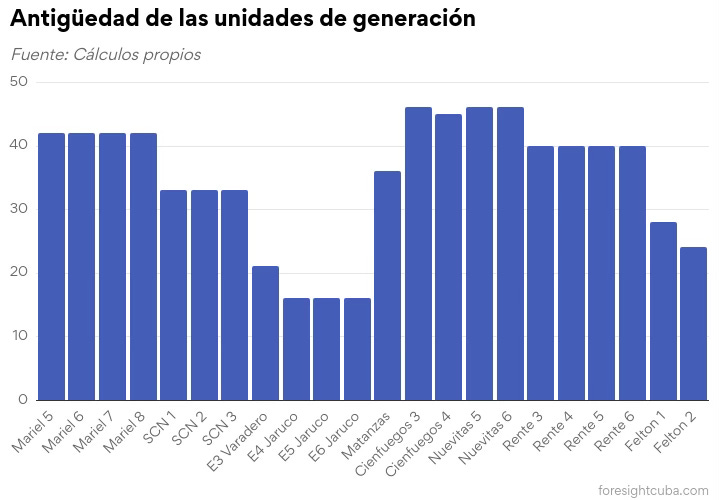The people of Cuba are asking why there are blackouts, how long they will last, why there are so many hours without electricity, why thermoelectric plants break down again even after repairs, and why investments are made in luxury hotels instead of thermoelectric plants, among other questions. We will attempt to explain the situation of the National Electric Power System in a series of articles. In this first article, we’ll provide an overview of the power-generating facilities.
The power outages occur because the National Electric Union has not invested in building new generation units to replace those that have exceeded their operational life. This lack of investment is due to the Cuban State not systematically allocating part of its budget for these investments. The absence of the rule of law, private property, non-payment of external debt, the inconvertibility of currency, and a lack of accountability from the government have led the country to bankruptcy. The National Assembly has also failed to require the State to fulfill its obligations to maintain the safe, efficient, and reliable operation of the National Electric Power System in the short, medium, and long term.
In addition to the lack of investment and a long-term strategic development plan for the energy sector, the plants use Cuban fuel with a high sulfur content, which does not meet the specifications for which the plants were designed. Moreover, most of the units operate without undergoing the required major maintenance. Both factors contribute to accelerated deterioration of the plants and constitute a blatant violation of operational standards.
In 2023, 15,331 GWh were generated, while transmission and distribution losses reached 3,716 GWh (24.2%). Peak demand is around 3,000 MW, but only with non-essential companies disconnected. Generation below this level results in blackouts for the population. The generation deficit reached 1,378 MW on February 13, 2024.
Cuba has 7 thermoelectric plants with 16 operational units. Generation units built before 1980 were dismantled without replacement. These include the units at the Tallapiedra, Regla, Frank País in Casablanca, José Martí in Matanzas thermoelectric plants; the four 50 MW units at the Mariel thermoelectric plant; units one and two at the Cienfuegos and Santiago de Cuba thermoelectric plants; and units one, two, three, and four at Nuevitas.
Mariel (Máximo Gómez, with four units of 100 MW installed capacity)
Santa Cruz (Ernesto Guevara, with three units of 100 MW)
Matanzas (Antonio Guiteras, one unit of 330 MW)
Cienfuegos (Carlos Manuel de Céspedes, two units of 158 MW)
Nuevitas (10 de Octubre, two units of 125 MW)
Felton (Lidio Ramón Pérez, two units of 250 MW)
Santiago de Cuba (Renté, three units of 100 MW)
The following chart shows the installed capacity per unit, with specific information on available power, as reported in the UNE’s daily reports.
In total, there are approximately 2,500 MW installed in thermoelectric plants, but the units are only able to generate around 1,000 MWh in total due to the deterioration of their facilities. The annual production in 2022 was 9,446 GWh, similar to the amount generated in 1982 and lower than the 9,961 GWh generated in 1993.

All the units have been in operation for more than 30 years, including seven that have been in service for over 40 years. Unit 6 at Mariel, which was modernized and synchronized in November 2021, is excluded. In March 2022, a fire in Unit 7 took it out of service again. In May 2023, restart tests for this unit began again. Felton Unit One was built in 1999 and Unit Two in 2021, but its boiler was dismantled.
To the power generated by thermoelectric plants, the output of generator sets should be added, with approximately 74,000 units imported between 2004 and 2020. By 2023, only some of these were connected to the system. These generator sets also do not receive adequate maintenance and were not designed for continuous operation. In 2022, there was an installed capacity of 2,046 MW, generating 3,273 GWh.
Sherritt has invested in Cuba in nickel and cobalt extraction, fertilizer production, and electricity generation. In the electricity sector, Sherritt owns one-third (33 1/3%) of the shares in a joint venture with Energás, whose stakeholders are the National Electric Union (UNE) and Cubapetróleo (CUPET). In 2023, Sherritt generated 745 GWh, with a generation cost of $27.70/MWh, while the selling price was $57.45/MWh. Sherritt operates three plants:
Puerto Escondido: One 20 MW gas turbine, totaling 506 MW.
Varadero: Combined-cycle plant commissioned in 2003, with 173 MW (three gas turbines and one steam turbine).
Boca de Jaruco: Combined-cycle plant commissioned in 2015, with a capacity of 356 MW (six gas turbines and one steam turbine).
In 2018, Energoimport and Karpowership signed a contract to install mobile floating power plants on the island. In 2019, the first two units were connected. Eight mobile power plants were installed in total, but in July 2023, two of these, with a capacity of 170 MW, left Cuba. Another floating plant left the island in April 2024. This type of mobile power plant has been installed in countries with struggling power systems or to meet high demand due to a large-scale event.
The mobile plants are positioned to replace the power that should have been generated by the thermoelectric plants in Mariel, Regla, Tallapiedra, and Renté. There is no official information on the names and capacity of these floating plants, but the following list was compiled from various press sources and the Karpowership website. ONEI reported 513.7 MW installed in 2023 as additional thermal generation:
Erol Bay (Regla, 63 MW)
Esra Sultan (235 MW, in Mariel)
Belgin Sultan (15 MW, Havana)
Baris Bay (40 MW, Mariel)
Ela Sultan (80 MW, in Mariel)
Erin Sultan (130 MW, moved from Havana to Renté, later left for Guyana)
KPS Irem Sultan (114 MW, Santiago de Cuba)
Suheyla Sultan (240 MW, Tallapiedra)
In 2023, these plants generated 4,493.8 GWh, a 173% increase compared to 2022.
Renewable energy generation (wind and solar) in 2023 was 237 GWh, representing 1.5% of total generation. In 2021, renewable generation was 265 GWh, showing a downward trend. Installed capacity is 266.7 MW, so the average renewable energy generation is 11.3% of the installed capacity.

Sources: ONEI, International Energy Agency
Spanish: Foresightcuba
Thanks for reading ForesightCuba’s Substack! Subscribe for free to receive new posts and support our work.







